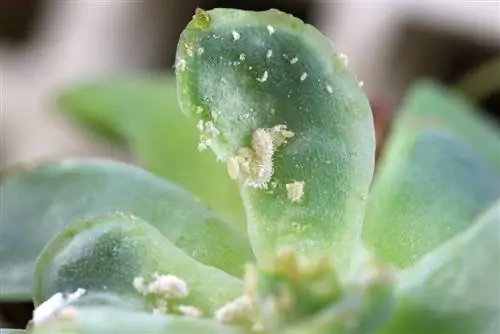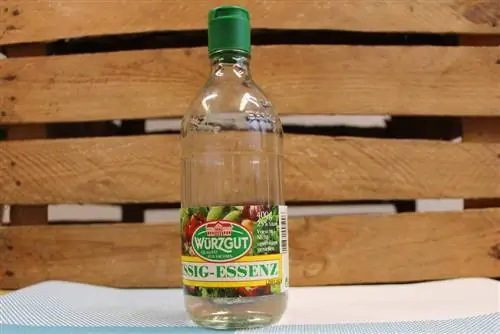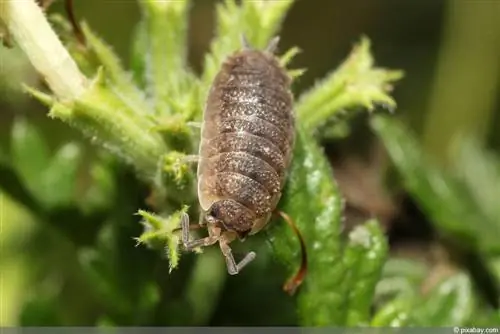- Author admin [email protected].
- Public 2023-12-17 03:39.
- Last modified 2025-06-01 06:48.
Bird mites in the chicken coop are a recurring and common problem. Because they are introduced by local wild bird species such as sparrows and then persist. Even if a bird mite infestation is not fatal for the chickens, they still suffer from severe itching. Therefore, the mites must be combated, ideally with non-chemical home remedies.
Prevention
The best remedy for annoying bird mites in the chicken coop is of course still prevention. A well-maintained and often cleaned stable is no less likely to be infested, but the bird mites are discovered more quickly and can therefore be combated right from the start. A mite goes through its life cycle within a week under optimal conditions. If the stable is cleaned well on a weekly basis, especially in summer, an infestation can be contained. The focus should be on the nesting possibilities of the red bird mite:
- likes to nest in corners
- between wooden boards
- in the litter
- in the bathing sand
It is therefore important to thoroughly clean all corners and gaps during weekly cleaning. This includes completely replacing the bedding as well as cleaning the walls and floor of the chicken coop with a steam jet. The sand should also be treated with a home remedy for bird mites.
Tip:
Prevention also includes observing and checking the chickens regularly. This is the only way to quickly detect a mite infestation and treat the animals.
Detecting bird mite infestations

If nested bird mites have reached the chickens, then the infestation on an animal can be recognized by some symptoms. If these are already more advanced, then it is already a massive infestation of bird mites that must be addressed immediately. The symptoms in the affected chickens look like this:
- Chicken loses too many feathers
- it loses weight
- the chicken no longer lays eggs
- there are bald spots under the wings
- also on the neck and anus
- can not only be bald but also sore
- infested chickens peck at each other
If one or more signs are the case, then the coop must be checked for annoying mites and the chickens themselves must be treated. Animals that do not yet show any signs should also be treated. Because it is never just one chicken in the chicken coop that is affected by an infestation.
Tip:
Natural chicken feed against mites that does not contain any chemical substances is available commercially. In this case, the grains are mixed with protective herbs and essential oils. Of course, these herbs and oils can also be added to normal feed and thus protect the chicken from the inside against mite infestation.
Proof in the stable
If the chickens are not yet infested with bird mites, the coop should still be checked regularly for possible infestations. However, the annoying arachnids are so small that they cannot be seen with the naked eye when they are in cracks or corners. Therefore, you can proceed as follows for proof:
- double-sided tape
- place this anywhere mites might be
- under cracks
- in corners
- on the wooden walls
The mites crawl onto the double-sided adhesive tape, get stuck and can therefore be quickly identified. Another advantage of the adhesive tape is that all areas where the parasites are located can be identified immediately and can therefore be treated in a timely manner with home remedies.
Tip:
If there is a suspected bird mite infestation in the chicken coop, it is also important to protect yourself. Long clothing, sturdy shoes and gloves should be worn for the work. If the mites have settled on your own body, it also helps to spread vinegar over a large area of the skin after showering.
Brush the perches
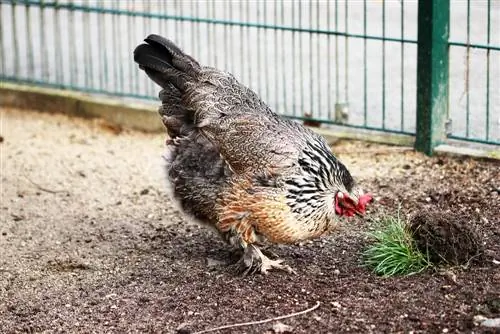
The bird mites get to the chickens especially via the perches. Therefore, after every thorough cleaning of the stable, it is important to make it inaccessible to the mites. This can be done simply by brushing the sticks with standard cooking oil. This doesn't bother the chickens, but the mites have difficulty moving over the oily surface and can't get to the sleeping chickens.
Tip:
Rubbing the poles with vinegar is also recommended.
Gun Oil - Ballistol
Many chicken owners believe that treatment with Ballistol, a gun oil, is successful. The Ballistol is available in stores for hunters or in various online shops. In order to be successful and combat the parasites, you should proceed as follows:
- Add oil to spray bottle with ten times the amount of water
- spray entire, previously cleaned stable
- rub the undiluted oil on the legs and under the wings of the chickens
- repeat every few days for acute infestation
Tip:
Alternatively, olive oil can be used instead of Ballistol. This has the advantage that it also smells better.
Vinegar against bird mites
To treat the infected chickens yourself, we recommend a treatment with pure vinegar. This is harmless to the chickens, but the parasites cannot tolerate this vinegar treatment at all. This simple but very effective home remedy can not only be used on chickens, it also helps against all kinds of mites on all other animals and even humans. Therefore, when used, the following happens:
- the acidity of the skin changes when applied
- Vinegar cannot harm the skin
- but the acidity increases
- this is how the living environment of the mites is changed
- the acid prevents the detection of food
- Mites are slowly being killed
- Eggs and larvae also die in the acidic environment
The feathers and skin of the chickens are rubbed with pure vinegar in the event of an infestation, with the affected areas on the neck, under the wings and on the anus of the animals in particular being treated. To do this, simply mix vinegar with a little water and rub it onto your hands and massage the mixture onto the animals down to the skin.
Tip:
The vinegar-water mixture can also be used regularly as a preventive measure, so that once infected chickens are not visited by the annoying mites again after the vinegar treatment. Through regular treatment, the acidic environment of the skin can be maintained and the parasites will avoid the treated chickens as hosts.
Rainsy as a dried herb

Rainsy does not belong to the fern family, but to the daisy family. The plant, also known as wormweed, is said to offer good biological protection against insects and parasites of all kinds. Tansy has button-like, dark yellow flowers and is often found along roadsides in late summer. When brewed as a dried herb, it can be used to combat the annoying bird mites in infected chickens. The procedure is as follows:
- pick along the side of the road in late summer and autumn
- dry for further use
- Hang in the bouquet with the flowers facing down
- in a dry, warm place
- Wooden cellar or storage well suited
30 grams of dried tansy are poured with a liter of boiling water to use against the mites. Use immediately after cooling because the mixture is not shelf-stable and should therefore not be stored. The broth is mixed 1:3 with water and sprayed throughout the previously cleaned chicken coop. The infected chickens can also be sprayed with the broth.
Tip:
If the mites have been successfully combated, then the tansy decoction can also be used as a preventive measure after every thorough cleaning of the chicken coop.
Use of diatomaceous earth
Not everyone has diatomaceous earth in their household, but anyone who owns a chicken coop should have it ready at all times. This is a powder made from diatoms. This is not a chemical, but a very natural remedy against bird mites. The procedure for using diatomaceous earth is as follows:
- dust the entire stable
- Ideally after complete cleaning
- Diatomaceous earth is particularly helpful when there is resistance to insecticides
- This scratches the shells of mites
- they dry out
- Reproduction is prevented
Diatomaceous earth is therefore also a very good remedy if there is a large infestation of bird mites in the stable. The chickens themselves can also be treated with this if they have an infestation. Simply put a little of the powder on the feathers and under the flights. Then rub lightly so that it reaches the skin.
Brightlime
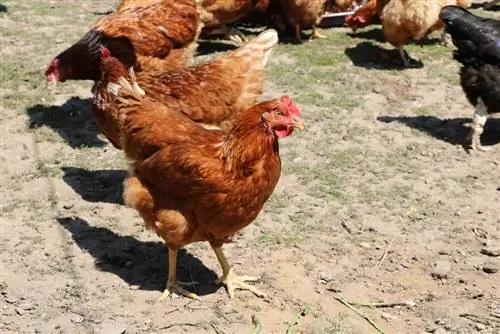
Branded lime is not only used on the lawn, in southern countries it is also used to paint walls and even entire houses. The lime can also be used in the chicken coop. The quicklime is mixed with hot water to create a sticky, thick mass. This can now be applied like paint with a brush or roller. This will now be used to whitewash the stable from the inside and outside. All cracks are closed with the lime mixture. The quicklime powder can also be scattered on the outdoor run.
Tip:
The positive side effect, in addition to combating and preventing bird mites in the coop, is that a whitewashed chicken coop or shed also looks very decorative and thus has a southern flair.
Use fragrance oils
In order to keep the chicken coop free of mites, you can also use products that have proven themselves in pigeon breeding. The bird mites that infect chickens are the same species that can also be found in pigeons. Therefore, the following home remedies also help to prevent bird mites from nesting in the chicken coop:
- preparing the stable with scented oils
- Lemon oil
- Eucalyptus oil
- Aniseed oil
- Put oils on walls and floor
- Hanging tobacco stalks in the chicken coop
Tip:
The scented oils can also be added to chicken feed in small quantities. The chickens ingest these with their feed, the mites will avoid the chickens.
Wood ash
Another home remedy that is supposed to help permanently against bird mites is wood ash. For this purpose, the entire chicken coop is thoroughly cleaned in advance and, if necessary, action is taken against mites that have already nested. The infected chickens are also treated. The new litter is then mixed with wood ash. This is intended to keep the annoying parasites away in the long term.



